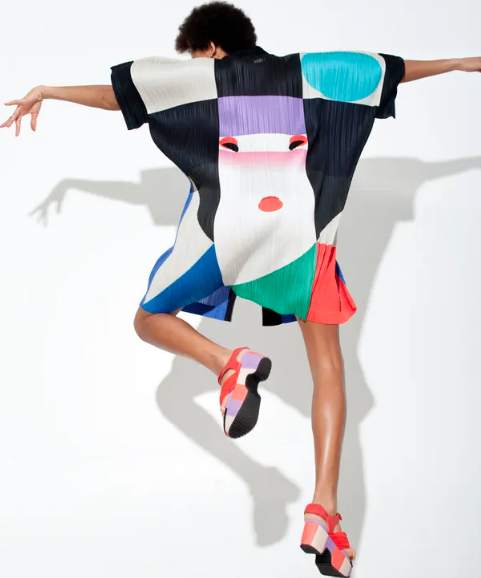Aug 4
Pleats Please & Flying Saucer Dresses: Celebrating the Life of Issey Miyake

Paper chase: Nihon buyo coat by Ikko Tanaka Issey Miyake. Fashion editor Jo Jones; make-up and hair Sarah Mireau at Soho Management using Bumble & Bumble and YSL beauty; Model Lily Lightbourne at M+P. Photograph: Kevin Foord/The Observer
On the 5th of August, Issey Miyake, an iconic Japanese designer tragically passed away from liver cancer aged 84. The world has lost an inspirational designer, who created everything from everyday wearable garments, such as the Steve Jobs polo neck, to groundbreaking runway looks like the flying saucer dress.
Issey Miyake was truly a genius pic.twitter.com/R80HENNSav
— @ncsweet_ (@ncsweet_) August 9, 2022
His career spanned over 5 decades as he continued to find new ways to challenge fashion design as we knew it. Whilst he retired in 1997 he remained the overseer of his multiple labels including Pleats Please, Issey Miyake, Issey Miyake Fête and his joint brand with Dai Fjuiwara, A-POC.
Born in 1938 Japan, he was just seven years old when the US released an atomic bomb in 1945. His mother died three years later due to radiation exposure. Initially, Miyake wanted to be a dancer (which Daniel Rodgers suggests may be a reason his garments facilitate and spotlight movement), however, his life took a different course. His sister's magazines sparked his interest in fashion, and after studying graphic design in Tokyo he decided to move to the other side of the globe, to Paris, where he attended the Chambre Syndicale De La Couture Parisienne school. Soon he became Guy Larcohe’s apprentice where he learned the skills to become the incredible designer he was. He was keen to refine his craft, drawing up to 100 sketches a day working with Hubert Givenchy.
Miyake saw fashion through a unique technological and sociological lens, exemplified by the fact he encouraged customers to customise their garments by cutting along the lines in his Queen and King collection, part of his A-POC label. In addition, he used his talent to draw attention to marginalised groups, which he did so in his runway show titled ‘Issey Miyake and 12 black girls’ in which black women took center stage.
RIP to the King of Pleats, Issey Miyake. - I pic.twitter.com/CgYZQCh3Xy
— IMONATION (@THEIMONATION) August 9, 2022
Unlike other high fashion designers, Pleats Please champions functionality. Items in the Pleats Please collection do not need to be dry cleaned, they are lightweight and wrinkle proof which means they can be easily folded up into a compact size. Miyake famously said ‘design is not for philosophy, but for life’ epitomising his focus on intertwining modern lifestyle with fashion, designing beautiful and wearable garments.
However, in 2016 Miyake designed a unique collection based on his Pleats Please line that was less practical and more visionary, involving the oven in his garment-making process.
HOW MIYAKE MADE THE PLEATS
2016 Spring Summer Collection
From his 2016 spring and summer collection, this blue dress showcases the texture of his pleat design and its versatility as a pattern. Usually, we see pleats vertically, but Miyake subverts the norm with horizontal pleating. To create this particular pleating effect he actually baked the clothes after printing the design, causing the pleats to lift and expose their true texture. Prior to baking Miyake laces the garments in glue, using a stamp to imprint wavy lines of adhesive onto the garment. Between the gaps of glue he adds different coloured dyes before the garments are placed in an oven.
When in the oven, the glue expands and rises to create a pleated texture on the fabric. Once removed from the oven, more dye is applied to the garment to add further colour, dimension and texture. The finished result is a unique piece of clothing with both rigidity and fluidity, bobbing along the runway as the model walks.
OUR FAVOURITE LOOKS
The 90s
Bold silhouettes and earthy tones defined Miyake’s 90s aesthetic. His innovative vision of shapes, movement and fashion combined to produce his beautiful designs. The flying saucer dress (pictured of the left) received a lot of attention in his 1994 Paris fashion show. To this day people are still reminiscing of the iconic design and the way it bounces through space.
The 10s
Miyake was intrigued by paper as a material, leading him to design the paper suit for his Fall Ready to Wear collection in 2011.
origami looks at issey miyake by dai fujiwara (2011) pic.twitter.com/YDPq7cb5S5
— laqerfeld (@laqerfeld) January 30, 2019
Recent Work
His recent designs continued to honour the craft Miyake had spent his life perfecting. Movement, texture, shape remain integral parts of his work.
We love this green dress Miyake from his Autumn and Winter 2022 collection. The contrast of the different shades of green further separates each section of the garment, emphasising the juxtaposition between the loose and tight-fitting parts of the dress.
As he continued to play with movement and texture into his late career, his ‘Into the Water’ collection from 2021 was made up of clothes made to look as though the wearer was underwater. The texture and colours are used to simulate the feeling of being submerged.
Whilst we say goodbye to a fashion legend, we are able to celebrate the thousands of people learning about his work and enjoying the beauty of his designs, five decades after he started his career.